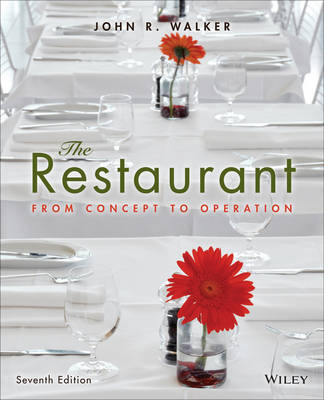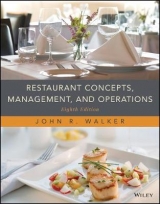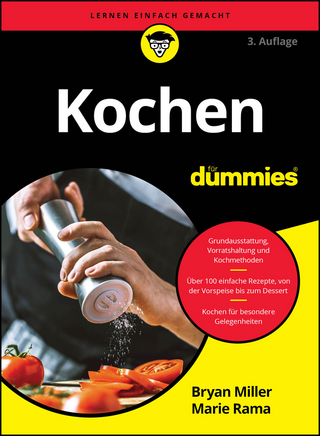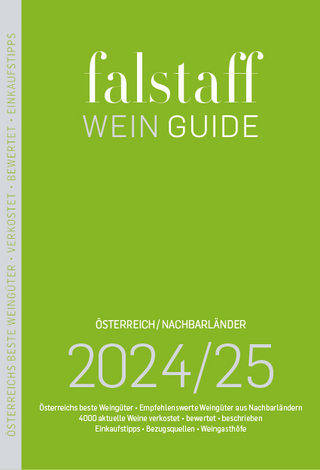
The Restaurant: From Concept to Operation
John Wiley & Sons Inc (Verlag)
978-1-118-62962-8 (ISBN)
- Titel erscheint in neuer Auflage
- Artikel merken
Preface ix Acknowledgments xiii
Part One Restaurants, Owners, Locations, and Concepts 1 The Concept of B. Café
Chapter 1 Introduction 3 Early History of Eating Out 5 French Culinary History 6 Birth of Restaurants in America 7 Challenges of Restaurant Operation 12 Buy, Build, Franchise, or Manage? 14 Starting from Scratch 17 Restaurants as Roads to Riches 18 Global Issues 19 Case Study: Castelli s Restaurant at 255 21
Chapter 2 Restaurants and Their Owners 24 Kinds and Characteristics of Restaurants 25 Sandwich Shops 29 Quick–Service Restaurants 30 Quick Casual Restaurants 32 Family Restaurants 33 Casual Restaurants 33 Fine–Dining Restaurants 35 Hotel Restaurants 36 Steakhouses 37 Seafood Restaurants 40 Ethnic Restaurants 40 Theme Restaurants 43 Coffee Shops 46 Chef–Owned Restaurants 47 Celebrity Chefs 51 Centralized Home Delivery Restaurants 54 Case Study: EVOS 56
Chapter 3 Concept, Location, and Design 60 Restaurant Concepts 61 Defi ning the Concept and Market 66 Successful Restaurant Concepts 67 Restaurant Life Cycles 71 Concept Adaptation 72 Restaurant Symbology 75 Multiple–Concept Chains 75 Sequence of Restaurant Development: From Concept to Opening 76 Planning Services 77 Common Denominators of Restaurants 77 Mission Statement 84 Concept and Location 85 Criteria for Locating a Restaurant 86 Location Information Checklist 98 Case Study: Wurstkuche 100
Part Two Menus, Kitchens, and Purchasing 103 Daniel Boulud
Chapter 4 The Menu 105 Considerations in Planning a Menu 107 Capability/Consistency 108 Equipment Capacity and Layout 108 Availability of Ingredients 108 Price and Pricing Strategy 109 Nutritional Value 112 Flavor 119 Accuracy in Menus 120 Menu Items 123 Menu Types 126 Menu Engineering 129 Menu Design and Layout 131 Standardized Recipes 132 Menu Trends 132 Case Study: Salt Gastropub 137
Chapter 5 Planning and Equipping the Kitchen 142 Back–of–the–House Green 146 Open Kitchen 147 Kitchen Floor Coverings 150 Kitchen Equipment 150 Equipment Stars 155 Maintaining Kitchen Equipment 163 Meeting with the Health Inspector 165 Case Study: Steuben s Food Service 167
Chapter 6 Food Purchasing 169 Sustainable Purchasing 170 Food–Purchasing System 172 Types of Purchasing 177 Buying Meat 178 Buying Fresh Fruits and Vegetables 180 Case Study: Farm Burger 185
Part Three Restaurant Operations 187 Concept of Aria Restaurant
Chapter 7 Bar and Beverages 189 Alcoholic Beverage Licenses 190 Bar Layout and Design 192 Beverages 194 Bartenders 198 Basic Bar Inventory 199 Wines 200 Responsible Alcoholic Beverage Service 211 Third–Party Liability 212 Controls 212 Coffee and Tea 214 Case Study: Classic Restaurant Concepts 216
Chapter 8 Operations, Budgeting, and Control 219 Restaurant Operations 220 Front of the House 220 Back of the House 227 Control 229 Liquor Control 231 Controllable Expenses 234 Labor Costs 235 Guest Check Control 241 Productivity Analysis and Cost Control 242 Case Study: Big Shanty Smokehouse 244
Chapter 9 Food Production and Sanitation 246 Our Culinary Heritage 247 Native American Infl uence 247 African American Infl uence 248 Italian Infl uence 248 French Infl uence 249 Receiving 253 Storage 254 Food Production 255 Production Procedures 258 Staffi ng and Scheduling 260 Foodborne Illness 260 Hazard Analysis of Critical Control Points 268 Common Food Safety Mistakes 269 Approaches to Food Safety 270 Food Protection as a System 271 Case Study: PDQ 274
Part Four Restaurant Management 277 Concept of Niche Restaurant
Chapter 10 Restaurant Leadership and Management 279 Leading Employees 280 The Nature of Leadership 283 Employee Input, and What s in It for Me? 284 Policies and Procedures 285 Management Topics 285 Restaurant Management Issues 290 Case Study: Eat Here 301
Chapter 11 Organization, Recruiting, and Staffi ng 304 Job Descriptions 305 Organizing People and Jobs 307 Staffi ng the Restaurant 309 Civil Rights Laws 317 Questions to Avoid on the Application Form and During the Interview 320 Careful Selection of Staff 324 Case Study: Short Street Cakes 327
Chapter 12 Training and Service 330 Orientation 331 Part–Time Employees 332 Training and Development 332 Methods for Training Employees 341 Service 344 Tact: Always 356 Case Study: Ophelia s on the Bay 358
Chapter 13 Technology in the Restaurant Industry 361 Technology in the Restaurant Industry 362 Table Management 372 PCI DSS 374 POS Systems 375 Mobile Phone Technology 376 Web–Based Enterprise Portals 378 Gift Card and Loyalty Programs 379 Guest Services and Websites 379 Restaurant Management Systems 380 Case Study: Carmel Café & Wine Bar 382
Part Five Business Plans, Financing, and Legal Matters 385 Concept of Panifi cio Café and Restaurant
Chapter 14 Restaurant Business and Marketing Plans 387 What Business Entity Is Best? 388 Buy Sell Agreement with Partners 394 Legal Aspects of Doing Business 394 Business Plan 398 The Difference between Marketing and Sales 402 Marketing Planning and Strategy 403 Market Assessment, Demand, Potential, and Competition Analysis 406 Marketing Mix The Four Ps 408 Case Study: Old Salty Dog 422
Chapter 15 Financing and Leasing 425 Financing 426 Suffi cient Capital 426 Preparing for the Loan Application 427 Uniform System of Accounts for Restaurants 432 Securing a Loan 438 Leasing 448 What Is a Restaurant Worth? 455 Case Study: Hopleaf 458
Glossary 461 Index 473
| Erscheint lt. Verlag | 3.1.2014 |
|---|---|
| Verlagsort | New York |
| Sprache | englisch |
| Maße | 193 x 240 mm |
| Gewicht | 1010 g |
| Themenwelt | Sachbuch/Ratgeber ► Essen / Trinken |
| Weitere Fachgebiete ► Handwerk | |
| ISBN-10 | 1-118-62962-0 / 1118629620 |
| ISBN-13 | 978-1-118-62962-8 / 9781118629628 |
| Zustand | Neuware |
| Informationen gemäß Produktsicherheitsverordnung (GPSR) | |
| Haben Sie eine Frage zum Produkt? |
aus dem Bereich



